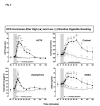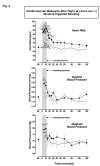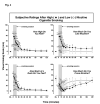Effects of low- and high-nicotine cigarette smoking on mood states and the HPA axis in men
- PMID: 15870834
- PMCID: PMC1383570
- DOI: 10.1038/sj.npp.1300753
Effects of low- and high-nicotine cigarette smoking on mood states and the HPA axis in men
Abstract
The acute effects of smoking a low- or high-nicotine cigarette on hypothalamic-pituitary-adrenal (HPA) hormones, subjective responses, and cardiovascular measures were studied in 20 healthy men who met American Psychiatric Association Diagnostic and Statistical Manual IV criteria for nicotine dependence. Within four puffs (or 2 min) after cigarette smoking began, plasma nicotine levels and heart rate increased significantly (P<0.01), and peak ratings of 'high' and 'rush' on a Visual Analogue Scale were reported. Reports of 'high', 'rush', and 'liking' and reduction of 'craving' were significantly greater after smoking a high-nicotine cigarette than a low-nicotine cigarette (P<0.05). Peak plasma nicotine levels after high-nicotine cigarette smoking (23.9+/-2.6 ng/ml) were significantly greater than after low-nicotine cigarette smoking (3.63+/-0.59 ng/ml) (P<0.001). After smoking a low-nicotine cigarette, adrenocorticotropin hormone (ACTH), cortisol, dehydroepiandrosterone (DHEA), and epinephrine did not change significantly from baseline. After high-nicotine cigarette smoking began, plasma ACTH levels increased significantly above baseline within 12 min and reached peak levels of 21.88+/-5.34 pmol/l within 20 min. ACTH increases were significantly correlated with increases in plasma nicotine (r=0.85; P<0.0001), DHEA (r=0.66; P=0.002), and epinephrine (r=0.86; P<0.0001). Cortisol and DHEA increased significantly within 20 min (P<0.05) and reached peak levels of 424+/-48 and 21.13+/-2.55 ng/ml within 60 and 30 min, respectively. Thus cigarette smoking produced nicotine dose-related effects on HPA hormones and subjective and cardiovascular measures. These data suggest that activation of the HPA axis may contribute to the abuse-related effects of cigarette smoking.
Figures




Similar articles
-
Effects of smoking successive low- and high-nicotine cigarettes on hypothalamic-pituitary-adrenal axis hormones and mood in men.Neuropsychopharmacology. 2008 Mar;33(4):749-60. doi: 10.1038/sj.npp.1301455. Epub 2007 May 16. Neuropsychopharmacology. 2008. PMID: 17507912 Clinical Trial.
-
Effect of cigarette smoking on ACTH/cortisol secretion in alcoholic after short- and medium-term abstinence.Alcohol Clin Exp Res. 1999 Sep;23(9):1515-8. Alcohol Clin Exp Res. 1999. PMID: 10512318
-
The effects of smoked nicotine on measures of subjective states and hypothalamic-pituitary-adrenal axis hormones in women during the follicular and luteal phases of the menstrual cycle.J Addict Med. 2015 May-Jun;9(3):195-203. doi: 10.1097/ADM.0000000000000117. J Addict Med. 2015. PMID: 25783522 Free PMC article.
-
Hormones, nicotine, and cocaine: clinical studies.Horm Behav. 2010 Jun;58(1):57-71. doi: 10.1016/j.yhbeh.2009.10.003. Epub 2009 Oct 14. Horm Behav. 2010. PMID: 19835877 Free PMC article. Review.
-
Endocrine effects of nicotine administration, tobacco and other drug withdrawal in humans.Psychoneuroendocrinology. 1998 Feb;23(2):131-41. doi: 10.1016/s0306-4530(97)00075-9. Psychoneuroendocrinology. 1998. PMID: 9621394 Review.
Cited by
-
Targeting the Brain Stress Systems for the Treatment of Tobacco/Nicotine Dependence: Translating Preclinical and Clinical Findings.Curr Addict Rep. 2016 Sep;3(3):314-322. doi: 10.1007/s40429-016-0115-x. Epub 2016 Jul 8. Curr Addict Rep. 2016. PMID: 31275802 Free PMC article.
-
Enhanced sensitivity to stress and drug/alcohol craving in abstinent cocaine-dependent individuals compared to social drinkers.Neuropsychopharmacology. 2008 Mar;33(4):796-805. doi: 10.1038/sj.npp.1301470. Epub 2007 Jun 13. Neuropsychopharmacology. 2008. PMID: 17568398 Free PMC article.
-
Sexually diergic hypothalamic-pituitary-adrenal (HPA) responses to single-dose nicotine, continuous nicotine infusion, and nicotine withdrawal by mecamylamine in rats.Brain Res Bull. 2011 May 30;85(3-4):145-52. doi: 10.1016/j.brainresbull.2011.03.001. Epub 2011 Mar 17. Brain Res Bull. 2011. PMID: 21396990 Free PMC article.
-
Association between smoking status and suicidal ideation, planning, and attempts among adults in South Korea: a population-based cross-sectional survey.Front Psychiatry. 2025 Jun 6;16:1440792. doi: 10.3389/fpsyt.2025.1440792. eCollection 2025. Front Psychiatry. 2025. PMID: 40547118 Free PMC article.
-
Effects of the kappa opioid receptor antagonist, norbinaltorphimine, on stress and drug-induced reinstatement of nicotine-conditioned place preference in mice.Psychopharmacology (Berl). 2013 Apr;226(4):763-8. doi: 10.1007/s00213-012-2716-y. Epub 2012 Apr 20. Psychopharmacology (Berl). 2013. PMID: 22526543 Free PMC article.
References
-
- U.S. Department of Health and Human Services, Centers for Disease Control and Prevention, National Center for Chronic Disease Prevention and Health Promotion. Office on Smoking and Health; Atlanta, GA: 2004. U.S. Department of Health and Human Services. The Health Consequences of Smoking: A Report of the Surgeon General; p. 941.
-
- Abreu ME, Bigelow GE, Fleisher L. Effect of intravenous injection speed on responses to cocaine and hydromorphone in humans. Psychopharmacology. 2001;154:76–84. - PubMed
-
- al'Absi M, Hatsukami DK, Davis GL, Wittmers LE. Prospective examination of effects of smoking abstinence on cortisol and withdrawal symptoms as predictors of early smoking relapse. Drug Alc. Depend. 2004;73:267–278. - PubMed
-
- al'Absi M, Wittmers LE, Erickson J, Hatsukami DK, Crouse B. Attenuated adrenocortical and blood pressure responses to psychological stress in ad libitum and abstinent smokers. Pharmacol. Biochem. Behav. 2003;74:401–410. - PubMed
-
- APA . Diagnostic and Statistical Manual of Mental Disorders. Fourth Edition American Psychiatric Association; Washington, D.C.: 1994. p. 886.
Publication types
MeSH terms
Substances
Grants and funding
LinkOut - more resources
Full Text Sources
Other Literature Sources
Miscellaneous

